-
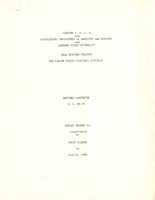 Robert Rhodes III interviewed by Doris Sirgew: "Retired Carpenter," Transcript.
Robert Rhodes III interviewed by Doris Sirgew: "Retired Carpenter," Transcript. Robert Rhodes III was born in Jackson and was a well known carpenter from doing work in the Farish Street District. He worked with his father, who owned a business in the district, until taking the business over for himself. He discusses his work during the Jim Crow Era and the difference in pay between white and Black carpenters.
-
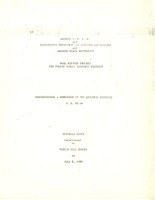 Stevella Adams interviewed by Virgie Ella Barnes: "Businesswoman & Homeowner in the Historic District," Transcript.
Stevella Adams interviewed by Virgie Ella Barnes: "Businesswoman & Homeowner in the Historic District," Transcript. Stevella Adams moved to Jackson in 1932 after graduating from college and getting married. Mrs. Adams talks about her time operating a grocery store on the corner of Monument and Blair Streets in the Farish Street District from 1952 to 1973. The store was originally owned and operated by her late father in law.
-
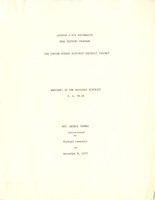 Rev. George Thomas interviewed by Michael Leveritt: "Resident in the Historic District," Transcript.
Rev. George Thomas interviewed by Michael Leveritt: "Resident in the Historic District," Transcript. Rev. George Thomas was a pastor at a church in Terry, Mississippi and also worked as a contractor and carpenter. He possessed several plans from early buildings which he built in the Farish Street District. He talks about the construction of new roads and buildings as Jackson converted from dirt roads and horses to a more metropolitan space.
-
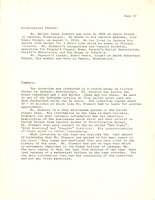 Walter Stewart interviewed by Michael Leveritt, Transcript.
Walter Stewart interviewed by Michael Leveritt, Transcript. Walter Stewart lived his entire life in the Farish Street District from 1910 and was the funeral director at People's Funeral Home in the district. He talks about the changes the area has gone through over the years and recounts several stories about people and places in the area. The transcript is edited with handwritten notes.
-
 Rev. Wendell P. Taylor interviewed by Ada Anderson, Transcript.
Rev. Wendell P. Taylor interviewed by Ada Anderson, Transcript. Rev. Wendell P. Taylor became minister at Central Methodist Church in the Farish Street District in 1963 and was retired at the time of the interview. He talks about the district being prosperous for Black businesses at that time but that a decline has taken place since businesses have left. The transcript is heavily edited with handwritten notes.
-
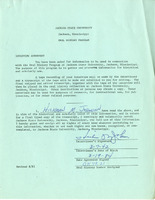 Rev. Hickman M. Johnson interviewed by Ada S. Anderson, Transcript.
Rev. Hickman M. Johnson interviewed by Ada S. Anderson, Transcript. Hickman M. Johnson came to Jackson in 1967 and had just finished his 10th year as pastor of Farish Street Baptist Church. He talks about the civil rights activist spirit that existed there in 1967. He goes on to discuss the deterioration of the district and discusses his ideas about how to revitalize the area. Transcript contains handwritten edits.
-
 Lee Williams interviewed by Eli Grayson, Transcript.
Lee Williams interviewed by Eli Grayson, Transcript. Lee Williams was born in 1900, moved to the Farish Street District in 1915, and lived on various streets for the rest of his life. He attended Smith Robertson School. In the interview, Mr. Williams recounts the different businesses, people, and schools over the years in the district. The transcript contains handwritten edits.
-
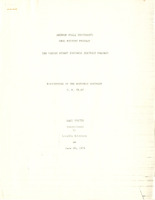 Gale Foster interviewed by Louella Robinson: "Businessman in the Historic District," Transcript.
Gale Foster interviewed by Louella Robinson: "Businessman in the Historic District," Transcript. Gale Foster moved to Jackson in 1912, attended Jackson State from 1912-1913, and opened City Barber, Beauty, and Tailor Shop in the Farish Street District in 1919. He talks about the current state of the district as well as offering advice to future Black business people, namely to get an education before starting a business.
-
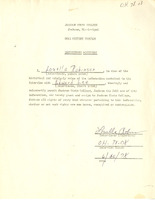 Edward Lee interviewed by Louella Robinson: "History of Black Owned Business," Transcript.
Edward Lee interviewed by Louella Robinson: "History of Black Owned Business," Transcript. Edward Lee moved to the Farish Street District in 1925 and went on to own businesses in the district including The Crystal Palace restaurant and lounge and the Edward Lee Hotel. Mr. Lee talks about his experiences with owning businesses in the district and gives advice to future Black business owners. Transcript is edited with handwritten notes.
-
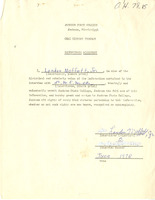 Dr. W.E. Miller interviewed by London Moffett, Jr: "Students at Smith Robertson School," Transcript.
Dr. W.E. Miller interviewed by London Moffett, Jr: "Students at Smith Robertson School," Transcript. Dr. W.E Miller was a physician and surgeon. He was born in 1903 and attended Smith Robertson School from 1908-1913. Dr. Miller talks about his time at Smith Robertson School and the community around the school, recounting the activities that were available for young people at the time. The transcript is edited with handwritten notes.
-
 Jess Brown interviewed by Catherine McMichael: "Attorney in the Historic District," Transcript.
Jess Brown interviewed by Catherine McMichael: "Attorney in the Historic District," Transcript. Attorney Jess Brown moved to the Farish Street District in 1948. He talks about his education and his legal career. He discusses his recollections of businesses on Farish Street and the effect that integration had on them. He also talks about the Civil Rights Movement and the NAACP and some of the cases he was involved with as a lawyer.
-
 Susie Noel interviewed by Dr. Alferdteen Harrison, Transcript.
Susie Noel interviewed by Dr. Alferdteen Harrison, Transcript. Susie Noel has lived in the Farish Street District since 1922. She talks about her experiences with the NAACP and the violence against Black people in the district during the Civil Rights Movement. She recounts her relationships with some of the Freedom Riders. She also talks about the different businesses and people in the district from the past.
-
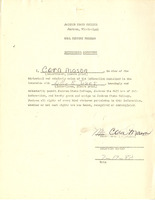 Lillie B. Jones Interviewed by Cora Mason, Transcript.
Lillie B. Jones Interviewed by Cora Mason, Transcript. Lillie B. Jones worked at the Farish Street Young Women’s Christian Association (Y.W.C.A.) from the beginning and talks about her experiences there and what the YWCA meant to the community. She also talks about her childhood and young adult days and going through the Great Depression. The transcript is edited heavily with handwritten notes.
-
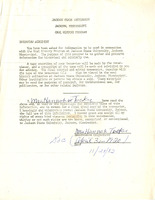 Hannah Tucker interviewed by Margaret Moore Abdullah, Transcript.
Hannah Tucker interviewed by Margaret Moore Abdullah, Transcript. Hannah Tucker moved to the Farish Street District in 1935 and opened Eat & Beat It Cafe in 1952. She talks about growing up in the district and some of the jobs she had. She also discusses some of the changes in the district over the years and her decision to soon move her business out of the district. Transcript is edited with handwritten notes.
-
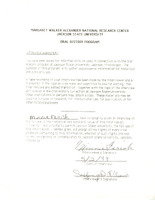 Minnie Farish interviewed by Tiffany D. Williams, Transcript.
Minnie Farish interviewed by Tiffany D. Williams, Transcript. Minnie Farish was born on Farish Street and lived her life there. Ms. Farish talks about her childhood on Farish Street and her time at Smith Robertson School and Lanier High School. She recounts the homes and businesses on Farish Street and talks extensively about her family. She also talks about what it was like living in the Jim Crow Era.
-
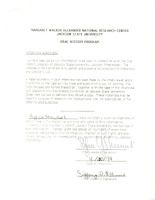 Sylvia Stewart interviewed by Tiffany D. Williams, Transcript.
Sylvia Stewart interviewed by Tiffany D. Williams, Transcript. Sylvia Stewart was born in the Farish Street District. Ms. Stewart talks about her experiences growing up in the district during the era of Jim Crow segregation; the business her grandfather and father owned; and her experiences with racism. The transcript is edited with handwritten notes.
-
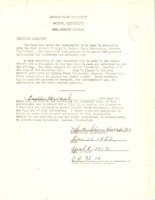 Esther Solomon Howard interviewed by Alferdteen Harrison, Transcript.
Esther Solomon Howard interviewed by Alferdteen Harrison, Transcript. Esther Solomon Howard was born in the Farish Street District in 1915. Ms. Howard talks about her childhood in the Farish Street District, including attending Smith Robertson School, Central Church, and the Young Women’s Christian Association (Y.W.C.A.). She also talks extensively about her husband. The transcript is edited with handwritten notes.
-
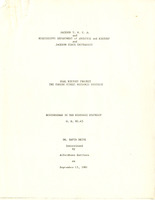 Dr. David White interviewed by Alferdteen Harrison, Transcript.
Dr. David White interviewed by Alferdteen Harrison, Transcript. Dr. David White was the first Black optometrist in the state of Mississippi when he moved onto Farish Street in 1951. He talks about Farish Street before and after integration: Black businesses became less prosperous after integration as some Black customers went to white owned businesses. He also talks about his involvement with the NAACP.
-
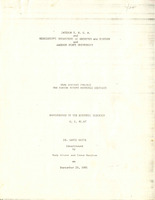 Dr. David White interviewed by Mary Street and Irene Hampton, Transcript.
Dr. David White interviewed by Mary Street and Irene Hampton, Transcript. Dr. David White was the first Black optometrist in the state of Mississippi when he moved onto Farish Street in 1951. He talks about how his first White customers came during the Civil Rights Movement as there was an active meeting place for activists above his business.
-
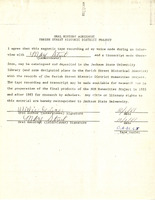 Willie Devine interviewed by Mary Street, Transcript.
Willie Devine interviewed by Mary Street, Transcript. Willie Devine lived many years in the Farish Street District. He talks about growing up and the activities he did, including swimming at the newly built pool and the music and dancing in the district. He recounts the harassment of young Black children by White people on the streets when he was in grade school.
-
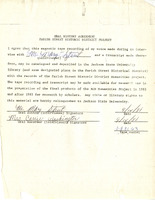 Carrie Washington interviewed by Mary Street, Transcript.
Carrie Washington interviewed by Mary Street, Transcript. Carrie Washington was born in 1895 and moved to the Farish Street District in 1933 and has lived there since. Ms. Washington talks about her time in the district and her experiences working in the homes of White people. She also talks about businesses and buildings in the district and the flood of 1927.
-
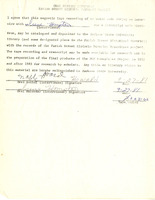 Mabel E. Howard interviewed by Irene Hampton, Transcript.
Mabel E. Howard interviewed by Irene Hampton, Transcript. Mabel E. Howard was born in the Farish Street District in 1911 and worked at several businesses in the district. She talks about her time living in the district, the schools she attended, and being baptized at Christ Temple Church, and her favorite places to eat in the district. The transcript is edited with handwritten and typed notes.
-
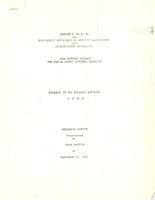 Gwendolyn Hampton interviewed by Irene Hampton: "Resident in the Historic District," Transcript.
Gwendolyn Hampton interviewed by Irene Hampton: "Resident in the Historic District," Transcript. Gwendolyn Hampton was born in the Farish Street District in 1953 and attended several schools in the area, including Smith Robertson School. Mrs. Hampton reflects on changes in many areas in the district, including the disciplining of neighborhood children and the attitude of "country folk" who came to Farish Street to shop.
-
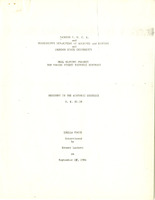 Idella Foot interviewed by Ernest Luckett: "Resident in the Historic District," Transcript.
Idella Foot interviewed by Ernest Luckett: "Resident in the Historic District," Transcript. Idella Foot moved to the Farish Street District in 1931 and lived her entire life on multiple different streets in the district. Ms. Foote discusses her children and her church affiliation. She also talks about the changes the district has undergone over the decades, saying that the district underwent big changes after the older generation died.
-
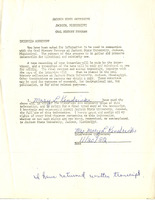 Mary L. Smith Kendricks interviewed by Cheryl A. Payne, Transcript.
Mary L. Smith Kendricks interviewed by Cheryl A. Payne, Transcript. Mary L. Smith Kendricks moved to the Farish Street District in 1929 and worked at several businesses in the district. She recounts her experiences as a child during the Great Depression and then her experiences with entertainment in the district in the 1940s and the present state of the district. Transcript is heavily edited with handwritten notes.
 Robert Rhodes III interviewed by Doris Sirgew: "Retired Carpenter," Transcript. Robert Rhodes III was born in Jackson and was a well known carpenter from doing work in the Farish Street District. He worked with his father, who owned a business in the district, until taking the business over for himself. He discusses his work during the Jim Crow Era and the difference in pay between white and Black carpenters.
Robert Rhodes III interviewed by Doris Sirgew: "Retired Carpenter," Transcript. Robert Rhodes III was born in Jackson and was a well known carpenter from doing work in the Farish Street District. He worked with his father, who owned a business in the district, until taking the business over for himself. He discusses his work during the Jim Crow Era and the difference in pay between white and Black carpenters. Stevella Adams interviewed by Virgie Ella Barnes: "Businesswoman & Homeowner in the Historic District," Transcript. Stevella Adams moved to Jackson in 1932 after graduating from college and getting married. Mrs. Adams talks about her time operating a grocery store on the corner of Monument and Blair Streets in the Farish Street District from 1952 to 1973. The store was originally owned and operated by her late father in law.
Stevella Adams interviewed by Virgie Ella Barnes: "Businesswoman & Homeowner in the Historic District," Transcript. Stevella Adams moved to Jackson in 1932 after graduating from college and getting married. Mrs. Adams talks about her time operating a grocery store on the corner of Monument and Blair Streets in the Farish Street District from 1952 to 1973. The store was originally owned and operated by her late father in law. Rev. George Thomas interviewed by Michael Leveritt: "Resident in the Historic District," Transcript. Rev. George Thomas was a pastor at a church in Terry, Mississippi and also worked as a contractor and carpenter. He possessed several plans from early buildings which he built in the Farish Street District. He talks about the construction of new roads and buildings as Jackson converted from dirt roads and horses to a more metropolitan space.
Rev. George Thomas interviewed by Michael Leveritt: "Resident in the Historic District," Transcript. Rev. George Thomas was a pastor at a church in Terry, Mississippi and also worked as a contractor and carpenter. He possessed several plans from early buildings which he built in the Farish Street District. He talks about the construction of new roads and buildings as Jackson converted from dirt roads and horses to a more metropolitan space. Walter Stewart interviewed by Michael Leveritt, Transcript. Walter Stewart lived his entire life in the Farish Street District from 1910 and was the funeral director at People's Funeral Home in the district. He talks about the changes the area has gone through over the years and recounts several stories about people and places in the area. The transcript is edited with handwritten notes.
Walter Stewart interviewed by Michael Leveritt, Transcript. Walter Stewart lived his entire life in the Farish Street District from 1910 and was the funeral director at People's Funeral Home in the district. He talks about the changes the area has gone through over the years and recounts several stories about people and places in the area. The transcript is edited with handwritten notes. Rev. Wendell P. Taylor interviewed by Ada Anderson, Transcript. Rev. Wendell P. Taylor became minister at Central Methodist Church in the Farish Street District in 1963 and was retired at the time of the interview. He talks about the district being prosperous for Black businesses at that time but that a decline has taken place since businesses have left. The transcript is heavily edited with handwritten notes.
Rev. Wendell P. Taylor interviewed by Ada Anderson, Transcript. Rev. Wendell P. Taylor became minister at Central Methodist Church in the Farish Street District in 1963 and was retired at the time of the interview. He talks about the district being prosperous for Black businesses at that time but that a decline has taken place since businesses have left. The transcript is heavily edited with handwritten notes. Rev. Hickman M. Johnson interviewed by Ada S. Anderson, Transcript. Hickman M. Johnson came to Jackson in 1967 and had just finished his 10th year as pastor of Farish Street Baptist Church. He talks about the civil rights activist spirit that existed there in 1967. He goes on to discuss the deterioration of the district and discusses his ideas about how to revitalize the area. Transcript contains handwritten edits.
Rev. Hickman M. Johnson interviewed by Ada S. Anderson, Transcript. Hickman M. Johnson came to Jackson in 1967 and had just finished his 10th year as pastor of Farish Street Baptist Church. He talks about the civil rights activist spirit that existed there in 1967. He goes on to discuss the deterioration of the district and discusses his ideas about how to revitalize the area. Transcript contains handwritten edits. Lee Williams interviewed by Eli Grayson, Transcript. Lee Williams was born in 1900, moved to the Farish Street District in 1915, and lived on various streets for the rest of his life. He attended Smith Robertson School. In the interview, Mr. Williams recounts the different businesses, people, and schools over the years in the district. The transcript contains handwritten edits.
Lee Williams interviewed by Eli Grayson, Transcript. Lee Williams was born in 1900, moved to the Farish Street District in 1915, and lived on various streets for the rest of his life. He attended Smith Robertson School. In the interview, Mr. Williams recounts the different businesses, people, and schools over the years in the district. The transcript contains handwritten edits. Gale Foster interviewed by Louella Robinson: "Businessman in the Historic District," Transcript. Gale Foster moved to Jackson in 1912, attended Jackson State from 1912-1913, and opened City Barber, Beauty, and Tailor Shop in the Farish Street District in 1919. He talks about the current state of the district as well as offering advice to future Black business people, namely to get an education before starting a business.
Gale Foster interviewed by Louella Robinson: "Businessman in the Historic District," Transcript. Gale Foster moved to Jackson in 1912, attended Jackson State from 1912-1913, and opened City Barber, Beauty, and Tailor Shop in the Farish Street District in 1919. He talks about the current state of the district as well as offering advice to future Black business people, namely to get an education before starting a business. Edward Lee interviewed by Louella Robinson: "History of Black Owned Business," Transcript. Edward Lee moved to the Farish Street District in 1925 and went on to own businesses in the district including The Crystal Palace restaurant and lounge and the Edward Lee Hotel. Mr. Lee talks about his experiences with owning businesses in the district and gives advice to future Black business owners. Transcript is edited with handwritten notes.
Edward Lee interviewed by Louella Robinson: "History of Black Owned Business," Transcript. Edward Lee moved to the Farish Street District in 1925 and went on to own businesses in the district including The Crystal Palace restaurant and lounge and the Edward Lee Hotel. Mr. Lee talks about his experiences with owning businesses in the district and gives advice to future Black business owners. Transcript is edited with handwritten notes. Dr. W.E. Miller interviewed by London Moffett, Jr: "Students at Smith Robertson School," Transcript. Dr. W.E Miller was a physician and surgeon. He was born in 1903 and attended Smith Robertson School from 1908-1913. Dr. Miller talks about his time at Smith Robertson School and the community around the school, recounting the activities that were available for young people at the time. The transcript is edited with handwritten notes.
Dr. W.E. Miller interviewed by London Moffett, Jr: "Students at Smith Robertson School," Transcript. Dr. W.E Miller was a physician and surgeon. He was born in 1903 and attended Smith Robertson School from 1908-1913. Dr. Miller talks about his time at Smith Robertson School and the community around the school, recounting the activities that were available for young people at the time. The transcript is edited with handwritten notes. Jess Brown interviewed by Catherine McMichael: "Attorney in the Historic District," Transcript. Attorney Jess Brown moved to the Farish Street District in 1948. He talks about his education and his legal career. He discusses his recollections of businesses on Farish Street and the effect that integration had on them. He also talks about the Civil Rights Movement and the NAACP and some of the cases he was involved with as a lawyer.
Jess Brown interviewed by Catherine McMichael: "Attorney in the Historic District," Transcript. Attorney Jess Brown moved to the Farish Street District in 1948. He talks about his education and his legal career. He discusses his recollections of businesses on Farish Street and the effect that integration had on them. He also talks about the Civil Rights Movement and the NAACP and some of the cases he was involved with as a lawyer. Susie Noel interviewed by Dr. Alferdteen Harrison, Transcript. Susie Noel has lived in the Farish Street District since 1922. She talks about her experiences with the NAACP and the violence against Black people in the district during the Civil Rights Movement. She recounts her relationships with some of the Freedom Riders. She also talks about the different businesses and people in the district from the past.
Susie Noel interviewed by Dr. Alferdteen Harrison, Transcript. Susie Noel has lived in the Farish Street District since 1922. She talks about her experiences with the NAACP and the violence against Black people in the district during the Civil Rights Movement. She recounts her relationships with some of the Freedom Riders. She also talks about the different businesses and people in the district from the past. Lillie B. Jones Interviewed by Cora Mason, Transcript. Lillie B. Jones worked at the Farish Street Young Women’s Christian Association (Y.W.C.A.) from the beginning and talks about her experiences there and what the YWCA meant to the community. She also talks about her childhood and young adult days and going through the Great Depression. The transcript is edited heavily with handwritten notes.
Lillie B. Jones Interviewed by Cora Mason, Transcript. Lillie B. Jones worked at the Farish Street Young Women’s Christian Association (Y.W.C.A.) from the beginning and talks about her experiences there and what the YWCA meant to the community. She also talks about her childhood and young adult days and going through the Great Depression. The transcript is edited heavily with handwritten notes. Hannah Tucker interviewed by Margaret Moore Abdullah, Transcript. Hannah Tucker moved to the Farish Street District in 1935 and opened Eat & Beat It Cafe in 1952. She talks about growing up in the district and some of the jobs she had. She also discusses some of the changes in the district over the years and her decision to soon move her business out of the district. Transcript is edited with handwritten notes.
Hannah Tucker interviewed by Margaret Moore Abdullah, Transcript. Hannah Tucker moved to the Farish Street District in 1935 and opened Eat & Beat It Cafe in 1952. She talks about growing up in the district and some of the jobs she had. She also discusses some of the changes in the district over the years and her decision to soon move her business out of the district. Transcript is edited with handwritten notes. Minnie Farish interviewed by Tiffany D. Williams, Transcript. Minnie Farish was born on Farish Street and lived her life there. Ms. Farish talks about her childhood on Farish Street and her time at Smith Robertson School and Lanier High School. She recounts the homes and businesses on Farish Street and talks extensively about her family. She also talks about what it was like living in the Jim Crow Era.
Minnie Farish interviewed by Tiffany D. Williams, Transcript. Minnie Farish was born on Farish Street and lived her life there. Ms. Farish talks about her childhood on Farish Street and her time at Smith Robertson School and Lanier High School. She recounts the homes and businesses on Farish Street and talks extensively about her family. She also talks about what it was like living in the Jim Crow Era. Sylvia Stewart interviewed by Tiffany D. Williams, Transcript. Sylvia Stewart was born in the Farish Street District. Ms. Stewart talks about her experiences growing up in the district during the era of Jim Crow segregation; the business her grandfather and father owned; and her experiences with racism. The transcript is edited with handwritten notes.
Sylvia Stewart interviewed by Tiffany D. Williams, Transcript. Sylvia Stewart was born in the Farish Street District. Ms. Stewart talks about her experiences growing up in the district during the era of Jim Crow segregation; the business her grandfather and father owned; and her experiences with racism. The transcript is edited with handwritten notes. Esther Solomon Howard interviewed by Alferdteen Harrison, Transcript. Esther Solomon Howard was born in the Farish Street District in 1915. Ms. Howard talks about her childhood in the Farish Street District, including attending Smith Robertson School, Central Church, and the Young Women’s Christian Association (Y.W.C.A.). She also talks extensively about her husband. The transcript is edited with handwritten notes.
Esther Solomon Howard interviewed by Alferdteen Harrison, Transcript. Esther Solomon Howard was born in the Farish Street District in 1915. Ms. Howard talks about her childhood in the Farish Street District, including attending Smith Robertson School, Central Church, and the Young Women’s Christian Association (Y.W.C.A.). She also talks extensively about her husband. The transcript is edited with handwritten notes. Dr. David White interviewed by Alferdteen Harrison, Transcript. Dr. David White was the first Black optometrist in the state of Mississippi when he moved onto Farish Street in 1951. He talks about Farish Street before and after integration: Black businesses became less prosperous after integration as some Black customers went to white owned businesses. He also talks about his involvement with the NAACP.
Dr. David White interviewed by Alferdteen Harrison, Transcript. Dr. David White was the first Black optometrist in the state of Mississippi when he moved onto Farish Street in 1951. He talks about Farish Street before and after integration: Black businesses became less prosperous after integration as some Black customers went to white owned businesses. He also talks about his involvement with the NAACP. Dr. David White interviewed by Mary Street and Irene Hampton, Transcript. Dr. David White was the first Black optometrist in the state of Mississippi when he moved onto Farish Street in 1951. He talks about how his first White customers came during the Civil Rights Movement as there was an active meeting place for activists above his business.
Dr. David White interviewed by Mary Street and Irene Hampton, Transcript. Dr. David White was the first Black optometrist in the state of Mississippi when he moved onto Farish Street in 1951. He talks about how his first White customers came during the Civil Rights Movement as there was an active meeting place for activists above his business. Willie Devine interviewed by Mary Street, Transcript. Willie Devine lived many years in the Farish Street District. He talks about growing up and the activities he did, including swimming at the newly built pool and the music and dancing in the district. He recounts the harassment of young Black children by White people on the streets when he was in grade school.
Willie Devine interviewed by Mary Street, Transcript. Willie Devine lived many years in the Farish Street District. He talks about growing up and the activities he did, including swimming at the newly built pool and the music and dancing in the district. He recounts the harassment of young Black children by White people on the streets when he was in grade school. Carrie Washington interviewed by Mary Street, Transcript. Carrie Washington was born in 1895 and moved to the Farish Street District in 1933 and has lived there since. Ms. Washington talks about her time in the district and her experiences working in the homes of White people. She also talks about businesses and buildings in the district and the flood of 1927.
Carrie Washington interviewed by Mary Street, Transcript. Carrie Washington was born in 1895 and moved to the Farish Street District in 1933 and has lived there since. Ms. Washington talks about her time in the district and her experiences working in the homes of White people. She also talks about businesses and buildings in the district and the flood of 1927. Mabel E. Howard interviewed by Irene Hampton, Transcript. Mabel E. Howard was born in the Farish Street District in 1911 and worked at several businesses in the district. She talks about her time living in the district, the schools she attended, and being baptized at Christ Temple Church, and her favorite places to eat in the district. The transcript is edited with handwritten and typed notes.
Mabel E. Howard interviewed by Irene Hampton, Transcript. Mabel E. Howard was born in the Farish Street District in 1911 and worked at several businesses in the district. She talks about her time living in the district, the schools she attended, and being baptized at Christ Temple Church, and her favorite places to eat in the district. The transcript is edited with handwritten and typed notes. Gwendolyn Hampton interviewed by Irene Hampton: "Resident in the Historic District," Transcript. Gwendolyn Hampton was born in the Farish Street District in 1953 and attended several schools in the area, including Smith Robertson School. Mrs. Hampton reflects on changes in many areas in the district, including the disciplining of neighborhood children and the attitude of "country folk" who came to Farish Street to shop.
Gwendolyn Hampton interviewed by Irene Hampton: "Resident in the Historic District," Transcript. Gwendolyn Hampton was born in the Farish Street District in 1953 and attended several schools in the area, including Smith Robertson School. Mrs. Hampton reflects on changes in many areas in the district, including the disciplining of neighborhood children and the attitude of "country folk" who came to Farish Street to shop. Idella Foot interviewed by Ernest Luckett: "Resident in the Historic District," Transcript. Idella Foot moved to the Farish Street District in 1931 and lived her entire life on multiple different streets in the district. Ms. Foote discusses her children and her church affiliation. She also talks about the changes the district has undergone over the decades, saying that the district underwent big changes after the older generation died.
Idella Foot interviewed by Ernest Luckett: "Resident in the Historic District," Transcript. Idella Foot moved to the Farish Street District in 1931 and lived her entire life on multiple different streets in the district. Ms. Foote discusses her children and her church affiliation. She also talks about the changes the district has undergone over the decades, saying that the district underwent big changes after the older generation died. Mary L. Smith Kendricks interviewed by Cheryl A. Payne, Transcript. Mary L. Smith Kendricks moved to the Farish Street District in 1929 and worked at several businesses in the district. She recounts her experiences as a child during the Great Depression and then her experiences with entertainment in the district in the 1940s and the present state of the district. Transcript is heavily edited with handwritten notes.
Mary L. Smith Kendricks interviewed by Cheryl A. Payne, Transcript. Mary L. Smith Kendricks moved to the Farish Street District in 1929 and worked at several businesses in the district. She recounts her experiences as a child during the Great Depression and then her experiences with entertainment in the district in the 1940s and the present state of the district. Transcript is heavily edited with handwritten notes.